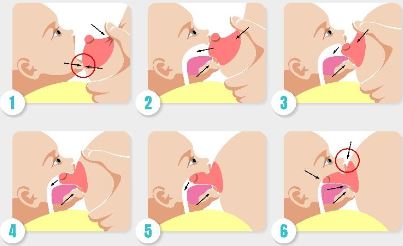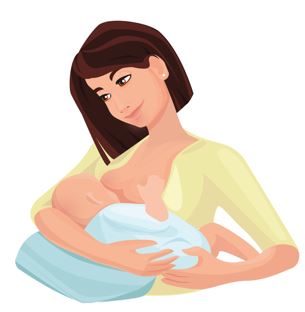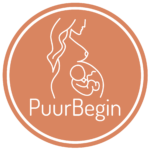- 085 40 19 095 (register + non-urgent questions)
- 06 42 61 01 99 (emergency, delivery)
Breastfeeding positions
1. Breastfeeding: how much does your baby need?
Breastfeeding is a wonderful, natural way to feed your baby and adapts to your child's needs. You may produce less milk in the first days after birth, but as your baby grows, the amount of breastfeeding will also increase. It's completely normal to worry about whether your baby is getting enough breast milk. After delivery, your baby's stomach is small, with room for about 10 ml of milk. Signs that your baby has had enough breastfeeding include falling into a deep sleep after feeding, waking about every 3 hours for a new feeding, and sucking becoming less vigorous as the feeding progresses. You may also notice that your breasts feel more supple after feeding, which is a sign that they have been properly emptied.
2. Breastfeeding: every 3 hours
It is essential to establish a good breastfeeding rhythm to breastfeed every 3 hours in the beginning. This not only helps stimulate milk production, but also gives your baby a consistent feeding schedule. Don't worry if your baby doesn't drink the same amount at each feeding. In the first 24 hours after birth, the baby often has enough reserves and does not necessarily need to eat. Nevertheless, it is important to offer breastfeeding every 3 hours, even when your baby is sleeping. Skipping feeding times can affect milk production.
3. Check your baby's temperature
It is advisable to measure your baby's temperature after every breastfeeding. This will help you get a better idea of your baby's overall health and well-being. Record the temperature and observe whether your baby has urinated or pooped after each feeding.
4. The importance of wet diapers
A good indication that your baby is being breastfed sufficiently is the number of wet diapers. A healthy newborn baby has about 4-6 wet diapers per 24 hours. Keep track of whether your baby has urinated at each feeding.
5. Provide a good bite
Correct breastfeeding technique is essential. If your baby sucks only on the tip of your nipple, it can cause pain. To ensure your baby takes a good bite, encourage him by brushing your nipple against his upper lip. This way he will eventually take a bigger bite and get the entire areola in his mouth. When your baby is drinking well, you will hear him swallow and see his jaw moving. This is a good sign that breastfeeding is going well.

6. Breastfeeding: duration and variety
Your baby can drink as long and as often as he wants. This promotes milk production. In the first few days it is good to let your baby drink from both breasts at every feeding time. Start with the breast you finished with last time. Let your baby nurse until he stops, burp him, and then offer the other breast.
7. Supplementary feeding: when not necessary
Breastfeeding is often all your healthy, full-term baby needs. In the first 24 hours after birth, even if breastfeeding has not yet fully started, supplementary feeding is usually not necessary. Babies who are born prematurely, too light or too heavy sometimes need extra nutrition. As a midwife, we will inform you about this if we deem this necessary, after we have consulted with a pediatrician.
9. Engorgement: what to do
Engorgement can occur when your milk 'comes in', usually around the fourth day after delivery. Your breasts may feel hard and painful. This is normal and indicates an increasing milk production. Breastfeeding more often can help. If the pain is severe, you can cool your breasts for relief. Be reassured that this fullness will decrease as breastfeeding stabilizes.
10. Breastfeeding positions
There are several breastfeeding positions you can try, such as the Madonna position, rugby position, side position, and upright sitting. Trying different positions can help you discover what works best for you and your baby:
Madonna or cradle pose
This is a classic breastfeeding position. Sit upright and hold your baby on your arm, with his stomach against your stomach. Support your baby's head and neck with your hand. Make sure your nipple touches your baby's upper lip.

Rugby stance
Ideal if you have had a caesarean section. Hold your baby at the side of your body, with his head near your chest and his body under your arm towards the back. A nursing pillow can provide support in this regard.

Side position
Lie on your side and place your baby next to you, belly to belly. This position is especially useful for night feedings or when you are recovering from childbirth.

Lie back
Lean back slightly and place your baby with his stomach against your stomach. The baby can find and grab the nipple itself. This position stimulates your baby's natural searching behavior.
Try different positions to see what works best for you and your baby. Every mother and baby is unique, so what works for one may not work for another. Don't forget to use pillows for extra support and comfort during feeding.

11. Express milk
If you notice that you are producing more milk than your baby needs, you may want to consider expressing some milk after the morning feed. You can save this milk for times when your production is lower. Make sure that you only do this after breastfeeding has properly started.
12. Nursing pads
It's normal to leak milk, especially when your baby is crying or nearby. Nursing pads in your bra can help catch leaking milk and keep you comfortable.
13. Take care of yourself: eat, drink and sleep
Zorg goed voor jezelf tijdens de borstvoedingsperiode. Eet gezond en drink voldoende water, want borstvoeding geven vergt veel energie en vocht. Beperk je inname van caffeine en alcohol. Huid-op-huid contact is ook belangrijk, zelfs als je geen borstvoeding geeft, om de band met je baby te versterken.
14. Finally, ask for help with breastfeeding
Don't hesitate to ask for help if breastfeeding is challenging. A lactation expert can support you and give you advice to ensure that your baby latches well and drinks effectively.
This extensive article about breastfeeding will hopefully provide you with valuable insights and practical tips to help you through this special period. Remember that every experience is unique and it is important to do what is best for you and your baby. We are here for you if you have any questions.
Dear greetings,
The midwives of PuurBegin
